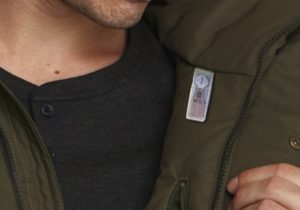LOOMIA’s technology launches in major menswear line this fall.

While wrist-worn mini-computers are now commonplace, a New York, N.Y.-based company is investing in a different wearables future, where technology is woven directly into clothes. LOOMIA designs and manufactures soft, flexible circuitry that can heat, light, sense and track data, while integrating—seamlessly—into soft goods with its LOOMIA Electronic Layer (LEL), the company’s core offering.
With IP in flexible, apparel-friendly connectors, components, custom battery form-factors and e-patterned materials, the company is positioned to provide technology components to a variety of end product markets in the long-term.
Its first launch, scheduled for this fall, will be in menswear from a major brand that’s powered with the LEL. This particular technology is a heating component in the form of a fabric layer that’s sewn into the garment.
“It will deliver heat to the user in one of the slimmest forms factors in the market,” Lynne Guey, LOOMIA’s head of communications says. “We’re currently talking to a number of brands. Shoes, menswear, women’s wear, active outerwear brands are all interested.”
But wait, there’s more…
Meanwhile, the company’s TILEtag, a component in the LOOMIA TILE, is going into production this summer. The TILEtag will store data about the garment’s performance and use. Data collected includes frequency of use, environmental conditions and where it is in its expected life cycle. Consumers can view their data and decide how it will be used.
“This will help consumers visualize their data and their habits and make better decisions—not to mention that if they do share their data with brands, there’s a financial reward,” says Guey.
Having the consumer control the data represents a major shift in data collection in wearable technology, and creates a strong incentive for brands to give consumers something in return in order to have access to this information.
“Brands want to know how customers are using their product, but right now they have no way of measuring that,” she says. “They [the Brands] have no idea what they’re doing with it, or how often it’s being worn.
Although high-end retail brands will be the first testers, the company sees potential beyond this rarified market. “There are definitely a lot of applications, and huge potential in the medical world, construction, fire fighting and military,” Guey says. “It’s a pretty novel technique that not many others are doing. We are launching a public utility token in the fall and so far, over 8,000 people have registered for our platform.”
Janet Preus is senior editor of Advanced Textiles Source. She can be reached at jlpreus@ifai.com.
 TEXTILES.ORG
TEXTILES.ORG


